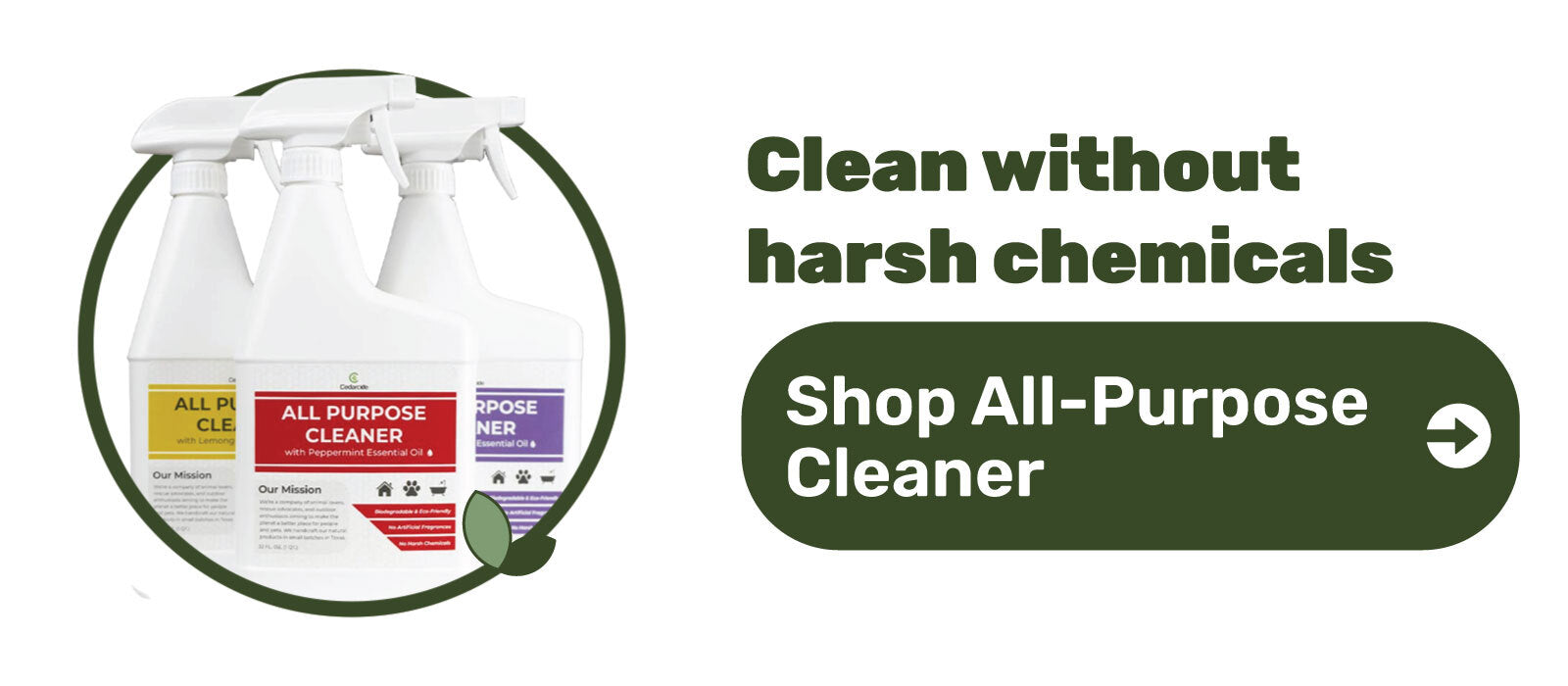
Sorry to start off with a bummer, but did you know that roughly 20% of all pets die from cancer? Environment is said to play a big role in the development of these cancers, so as pet parents we need to be extra careful with the type of environment we create for our cats and dogs. Reducing harmful chemicals and practicing basic hygiene and cleanliness are essential to upping your pet care game. As you spring clean this year, keep your animal’s wellbeing in mind with these 8 Spring Cleaning tips for Pet Parents.
1. UPGRADE YOUR CLEANERS & SKIP THE CHEMICALS!
According to the EPA, indoor air pollution can be up to 100 times worse than outdoor air pollution. Household cleaners and air fresheners are a big reason why, which means spring cleaning is an easy way to introduce noxious chemicals into the home.
Because these toxins can be inhaled, inadvertently ingested and absorbed through the skin—causing hormonal and neurological problems and even cancer in both pets and people—we strongly advise switching to more natural cleaning alternatives, such as our new All-Purpose Cleaner.

2. CLEAN TOYS & FOOD/WATER BOWLS
Pet toys and feeding bowls are magnets for bacteria, so make sure they’re cleaned regularly. For hard rubber and plastic toys and bowls, soak them in a 50/50 mixture of vinegar to water for at least 30 minutes. Thoroughly scrub after soaking, and then air dry. Soft toys can be cleaned in your washing machine’s gentle cycle, so long as you use a natural detergent that won’t harm your pet. Because these toys can be fragile, skip the dryer and hang dry instead. Lastly, donate or recycle any extra or unwanted toys you find in the cleaning process.
3. DON'T FORGET TO CHECK THEIR COLLAR
While most pet parents routinely bathe their pets, many forget to routinely clean their pet’s collar. It doesn’t matter how clean your pet is, if their collar smells they’re going to smell. Simply submerge the collar in hot water with a few drops of natural pet shampoo. Soak for roughly 30 minutes, rinse with water and hang to dry. Lastly, use this opportunity to double check the condition of your pet’s collar and tags. Make sure they still fit snugly, are not fraying or close to breaking, and that all identification info is legible and up to date. Replace as needed.
4. REFRESH BEDDING
Pet bedding and beds usually don't get cleaned nearly enough, and there’s really no excuse because it’s super easy. Washing bedding and beds is as simple as throwing them in the washing machine with a natural, pet-friendly detergent. To keep bedding fresh between washes, reach for a naturally sourced pet bedding deodorizer, like our new Pet + Bedding + Home Spray.
5. CLEAN THE CRATE, TOO
It’s easy to forget to clean crates and carriers, especially if you don’t use them often, but doing so is really important as they can house loads of germs and bacteria. Using a pet-safe all-purpose cleaner, scrub both inside and outside the crate, making sure to address all nooks and crannies. If your crate/carrier includes a removable liner, remove and thoroughly clean that as well.
6. UPGRADE YOUR PEST CONTROL
It’s time to ditch the toxic pesticides already. Traditional pesticides and repellents— whether for yourself, your pets, home or yard—contain unbelievably dangerous chemicals. Worse yet, these chemicals almost always end up somewhere other than their intended destination, such as on flooring, kitchen countertops, and inside your pets’ and family’s bloodstreams. When going non-toxic with your pest control, you’ll need to do it for both indoor and outdoor pesticides like PCO Choice to prevent chemical exposure. The same goes for personal bug-repellents: When camping or hiking with your pup, switch out chemical-based sprays for naturally sourced, pet-safe alternatives.

7. TACKLE HAIR AND SHEDDING
There are two types of pet hair: The type that’s still attached to your animal, and the kind that’s already jumped ship. When spring cleaning, you’ll need to tackle both. Many cats and dogs shed more throughout spring, so extra brushing might be required. (Because the right brush depends on your pet’s breed and unique coat, check with a vet or pet store for help finding one that’s appropriate for your cat or dog.) Regular vacuuming will help address shedding throughout the home, but for the tough task of removing hair from linens and upholstered furniture, reach for a rubber glove. Moisten but do not soak the glove in water, and run it over surfaces to collect unwanted pet fur. Repeat as needed.
8. PREVENT MUDDY PAW PRINTS
As pet parents, it’s easy to dread spring’s rainy days and the muddy paw prints they can leave throughout our homes. An easy way to tackle this problem is to keep a bucket of warm, soapy water and a towel by the door during stormy weather (use only pet-safe soap, of course!). Clean paws with a quick dip and towel dry to finish. It might take some time for your pet to get accustomed to waiting by the door before coming inside, but with repetition they should pick it up fairly quickly.

